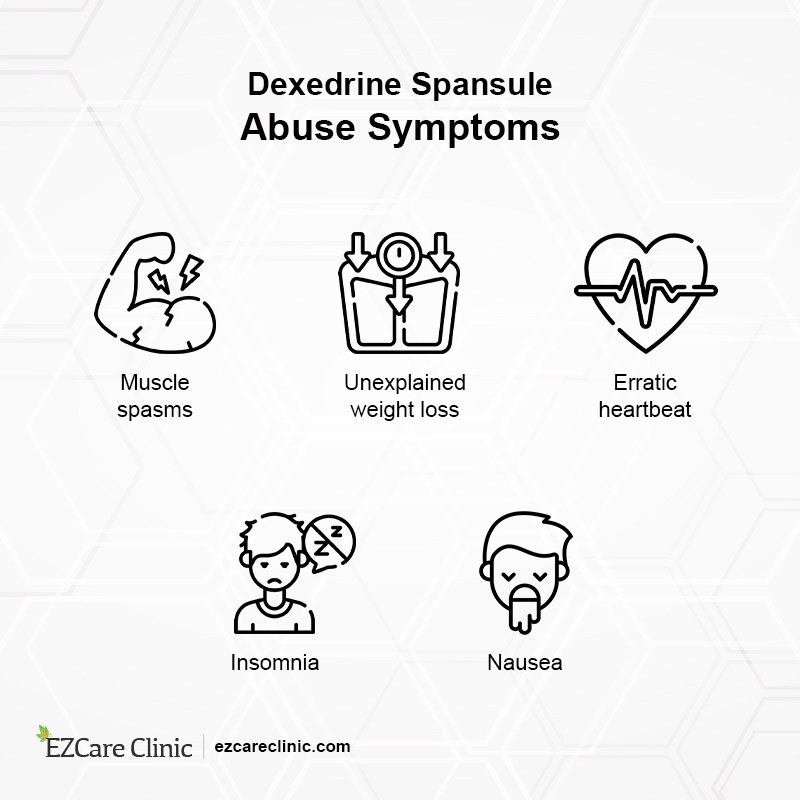Dexedrine Spansule is simply a CNS drug that affects chemicals in your nerves and brain. These chemicals play an active role in impulse and hyperactivity control. The drug is mainly used to treat conditions like attention-deficit hyperactivity disorder (ADHD) and narcolepsy among others.
Get your ADHD symptoms checked and controlled- Click below to schedule your appointment.
Dexedrine Spansule Classification
Dexedrine Spansule belongs to a drug class known as central nervous system (CNS) stimulants.
Its generic name is dextroamphetamine while the brand name is:
- Dexedrine Spansule
- Zenzedi
- ProCentra
How Dexedrine Spansule Capsules Are Used?
If you’re new to Dexedrine Spansule capsules, you should read through the patient information leaflet and medication guide provided alongside this drug. The same process must be repeated each time you go for a refill.
Ask your caregiver questions in case you have doubts about the usage of Dexedrine Spansule capsules.
However, make sure to take this medication orally with or without food. Usually, 1-3 times per day is recommended with the first dose being taken in the morning when you wake up.
In case of more doses, ensure that you follow your doctor’s advice. Normally, the dosage is prescribed depending on your response to treatment and medical condition. Your healthcare provider may adjust the dose to find the most appropriate one for you.
What’s Dexedrine Spansule Used for?
As stated above, Dexedrine Spansule treats attention-deficit hyperactivity disorder (ADHD). This medication changes the levels of certain natural substances in your brain. That’s why it’s considered a stimulant.
Dexedrine Spansule has the ability to increase your attention, control behavior problems, and help you stay focused on specific activities.
Further, the drug can help you improve your listening skills and organize your tasks.
You can as well use Dexedrine Spansule to treat narcolepsy, a disorder that can affect your sleeping ability so you can stay awake throughout the day.
How Should I Take Dexedrine Spansule?
Remember to swallow Dexedrine Spansule capsules whole and not to chew or crush them. Swallowing this capsule helps to release it into your body system gradually. Doing so helps prevent the risk of side effects.
You should also take this medication regularly in order to get the most health benefits from it.
Make sure to take it daily and at the same time as prescribed by the doctor.
If you stop using Dexedrine Spansule, you may experience withdrawal symptoms such as:
- Sleep problems
- Severe tiredness
- Mood changes (depression)

Common Side Effects of Dexedrine Spansule
What’s the Right Dexedrine Spansule Dosage?
The dose for Dexedrine Spansule varies from one patient to another. However, you should follow your healthcare provider’s orders or read and understand the directions provided by the manufacturer.
The amount of Dexedrine Spansule mediation that you can take depends largely on the effectiveness and strength of the medicine itself.
The number of doses taken per day, duration of taking this medicine, and the interval allowed between doses depend on your medical problem.
Here is the dosage for the following medical conditions:
1. Attention Deficit Hyperactivity Disorder (ADHD)
Here is the oral dosage for attention-deficit hyperactivity disorder:
- Oral Dosage Form Sustained-Release Capsules
- Adults and kids above six years old take 5 mg twice a day at the start of the treatment. The doctor may adjust the dose if necessary.
- Children below six years old are not recommended taking Dexedrine Spansule medication.
- Oral Dosage Form (Tablets)
- Adults and children aged above six years take 5 mg two times per day at the beginning of their treatment. The doctor may adjust the dosage if needed.
- Children aged between three and five years take 2.5 mg per day at the beginning of Dexedrine Spansule treatment. The dose might be adjusted if needed.
- The doctor must determine the use and dosage for kids younger than three years of age.
Suffering from ADHD symptoms? Click the button below to schedule your appointment with a mental health professional.
2. Narcolepsy
Here is the oral dosage for narcolepsy:
- Oral Dosage-Sustained-release Tablets or Capsules
- Adults and children aged 12 and above take 10 mg once per day at the beginning of Dexedrine Spansule treatment. The dose may be adjusted by the doctor if needed.
- Children aged six to 12 years take 5 mg once per day at the start of Dexedrine Spansule treatment. The dose may be adjusted by the doctor if necessary.
- Use and dose should be determined by the doctor for children below six years of age.
Dexedrine Spansule Warnings/ Precautions
Before taking Dexedrine Spansule you should be sure of your health history. This medication may not work well for you if you have certain underlying health conditions.
Below are Dexedrine Spansule warnings you should know:
- Overactive thyroid
- Moderate to severe hypertension (high blood pressure)
- Heart disease
- Coronary artery disease (hardened arteries)
- Glaucoma
- History of alcohol or drug addiction
- Severe anxiety, agitation, or tension
You should also not take Dexedrine Spansule medication if you’ve been using any of the MAO inhibitors in the past two weeks. This is because a dangerous drug interaction may occur and cause more problems.
Examples of MAO inhibitors include:
- Linezolid
- Isocarboxazid
- Phenelzine
- Methylene blue injection
- Selegiline
- Rasagiline
- Tranylcypromine
What Happens if I Miss a Dose?
You should take your missed dose of Dexedrine Spansule as soon as you possibly can.
Don’t take it late in the day. If it’s almost evening you can skip your missed dose. Taking it late in the day may interfere with your sleep.
Most importantly, don’t proceed to take extra medication to compensate for the missed dose.
What Are the Side Effects of Dexedrine Spansule?
Spansule side effects are many and can affect different parts of your body.
That said, possible side effects of Dexedrine Spansule include:
- Upset stomach
- Headache
- Decreased appetite
- Dizziness
- Insomnia
- Tremors
- Weight loss
- Dry mouth
Major side effects of this medication can include:
- Blurred vision
- Seizures
- Stroke
- Hypertension
Children on Dexedrine Spansule medication may experience a slow but temporary growth rate. As soon as you notice any of the above-mentioned side effects, make sure to inform your doctor and stop taking the medication.
What Other Drugs Can Affect Dexedrine Spansule?
Drug interaction when it comes to Dexedrine Spansule can be beneficial or risky.
The most likely drugs that can affect the working of Dexedrine Spansule:
- Iproniazid
- Linezolid
- Methylene Blue
- Nialamide
- Procarbazine
- Rasagiline
- Selegiline
- Tranylcypromine

Abuse Symptoms of Dexedrine Spansule
Although not recommended to be used with Dexedrine Spansule, the following medicines may be required in rare cases:
- Abiraterone Acetate
- Alfentanil
- Aluminum
- Benzhydrocodone
- Benzthiazide
- Calcium Carbonate
- Chlorothiazide
- Citalopram
- Codeine
- Diazoxide
- Difenoxin
- Eletriptan
- Esomeprazole
- Fentanyl
- Granisetron
- Hydrocodone
- Hydromorphone
- Lithium
- Methadone
- Nefazodone
- Oxycodone
- Palonosetron
- Protriptyline
- Ritonavir
- Sodium Bicarbonate
- Terbinafine
- Trazodone
- Venlafaxine
- Xipamide
- Zolmitriptan
Learn to manage your ADHD symptoms– Schedule your appointment with an ADHD expert by clicking the button below.
Final Thought
If you are diagnosed with ADHD or Narcolepsy, you should get yourself checked immediately so that your doctor can start the most suitable treatment depending on your medical history.
Contact EZCare Medical Clinic today or schedule your appointment by clicking the banner below.

